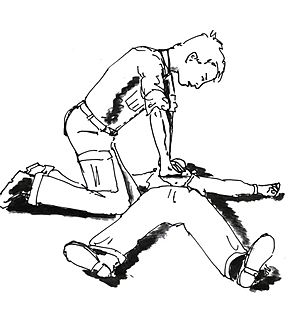Resuscitation facts for kids
Resuscitation is a very important first aid action you can take in a medical emergency. It's given to someone who is unconscious (meaning they are not awake or responding) and when you can't feel their pulse or see them breathing. The main goal of resuscitation is to keep oxygen flowing to their heart and brain. This helps keep their vital organs alive until medical professionals, like a doctor, can take over and try to restart their heart, hopefully without causing any brain damage.
One common reason someone might need resuscitation is a heart attack. This happens when blood flow to the heart is blocked.
Contents
Resuscitation: Helping in an Emergency
Resuscitation is a life-saving skill that anyone can learn. It's about acting quickly and calmly when someone's life is in danger. Knowing what to do can make a huge difference.
What is Resuscitation?
Resuscitation means bringing someone back to life or helping them recover. In medical terms, it often refers to actions like cardiopulmonary resuscitation (CPR). CPR involves pressing on the chest and sometimes giving rescue breaths. These actions help pump blood and oxygen around the body when the heart isn't working properly.
Why is Resuscitation Important?
When a person's heart stops or they stop breathing, their brain and other organs quickly run out of oxygen. Brain cells can start to die within minutes without oxygen. Resuscitation helps to keep oxygen moving to the brain and heart. This buys precious time until trained medical help arrives. It can prevent serious brain damage and even save a life.
When Someone Needs Help: What to Do
If you find someone who might need help, it's important to follow a few key steps. These steps are designed to keep everyone safe and get the right help quickly.
Step 1: Check for Danger
Before you do anything, always make sure the area is safe for you and the person who needs help. Look for things like traffic, falling objects, or anything that could hurt you. If it's not safe, try to make it safe or call for help from a distance. Your safety comes first!
Step 2: Check the Person
Once it's safe, gently approach the person. Try to get their attention.
- Talk to them loudly: "Are you okay?"
- Ask clear questions: "Can you hear me?" "Open your eyes!"
- Gently tap their shoulder.
- If they respond by moving, talking, or opening their eyes, they probably don't need resuscitation. They might need other help, but not this specific emergency action.
- If they do not respond at all, they are unconscious. Now you need to check if they are breathing normally. Look, listen, and feel for breaths. If they are not breathing normally or not breathing at all, they need immediate help.
Step 3: Call for Help
If the person is unconscious and not breathing normally, you need to get help right away.
- Shout for someone nearby to call your local emergency number (like 911 in the US or 999 in the UK).
- If you are alone, call the emergency number yourself and put your phone on speaker.
- Tell the operator exactly where you are and what has happened. They will guide you on what to do next, which might include starting CPR.


